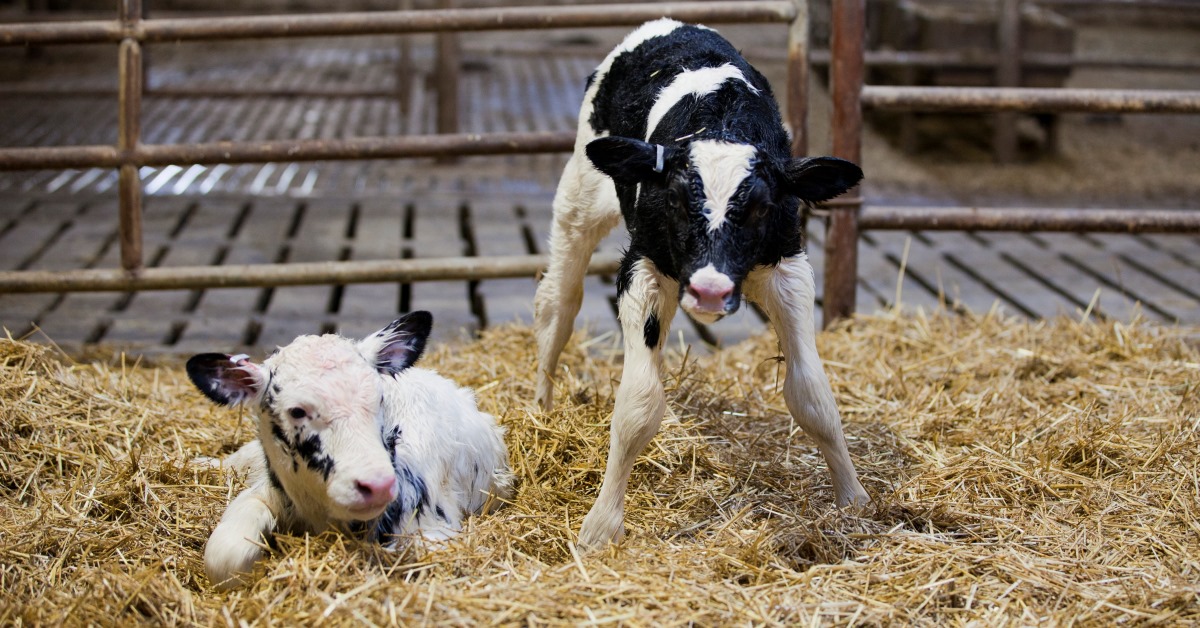
Why is caring for the umbilical cords of newborn calves important?
As is true for all mammals, the umbilical cord serves as the pathway from the dam’s bloodstream to the calf’s bloodstream and liver, offering nourishment and waste removal during gestation. At birth the cord ruptures, disconnecting the dam from the calf, and the umbilical stump is left dangling from the calf’s navel where it eventually dries up and falls off. Before the cord dries, the passageway to the calf’s bloodstream is still open, leaving the naïve immune system of the calf susceptible to infection and disease via navel contamination. Not only can an umbilical infection cause sepsis and death in newborn calves, but it can also lead to reduced body weight gain in early life. Studies indicate that 15–20% of dairy calves in the United States develop umbilical infections, with 1.6% of those causing death.
What can we do to ensure that we are preventing navel infections in newborn calves?
The first measure that needs to be taken to avoid navel infections is to make sure that calves are born into a clean, dry environment with fresh bedding. Dirty maternity pen conditions can expose the calf to pathogens immediately upon contact, significantly increasing her risk of navel ill. Umbilical infections are most commonly caused by Staphylococcus aureus, Streptococcus bovis and E. coli.
The next step in navel infection prevention is to dip the external part of the umbilical stump with an effective dipping solution (more on this below). In order to help avoid infection, it is important to dip the cord as soon as possible after birth, when the cord is the most open, wet and fresh. Ensure the entire cord is submerged in the solution. Calf raisers typically use small, disposable cups to dip the cord; this allows for complete coverage and also limits calf-to-calf pathogen exposure, as the cups are treated as single-use only. Using a spray bottle to spray the solution on the navel and cord is often inadequate, as the spraying does not offer consistent, total coverage, making the cord susceptible to pathogen exposure.
Some examples of umbilical dip solutions include:
- 7% tincture iodine solution (preferred) — the alcohol (tincture) present in the solution helps to dry out the cord. A diluted iodine solution below 7% will not offer the protection a calf needs and has been shown to be ineffective
- 4% chlorhexidine
- Triodine 7, a 2.4% titratable iodine
- Navel-Guard — a purified-water, acidified-water and isopropyl-alcohol product
- Super 7 Ultra Navel Care — a product that features neither iodine nor alcohol
The first and second options above are currently the most common umbilical dip choices used in the field. The interest in exploring the effectiveness of the latter options has recently increased due to federal regulations regarding the sale and storage of 7% iodine solutions. It is important to note that a teat dip used in the milking parlor is not an effective umbilical dip.
Even with proper umbilical dipping, calves can still be susceptible to navel infections, joint ill and morbidity if navels aren’t managed properly. Wet, dirty bedding in calf hutches and/or pens enables the umbilical cord to stay wet and pliable, resulting in an increased risk for infectious pathogens to enter. In circumstances that make maintaining dry, clean bedding difficult, consider re-dipping the navel 24 hours, and again 48 hours after the first dipping to promote drying and deter bacteria.
Navel monitoring
It is important to check the navel area two to three times during the first week of life (until the cord is fully healed and dry) in order to help prevent umbilical infections.
- Palpate the cord at three to five days of age. The cord should not be any bigger than the diameter of a pencil. It should also be soft and pliable. A hardened navel that is enlarged or causes the calf discomfort when squeezed may indicate a navel infection.
- Palpate the cord of any calf showing signs of illness or fever under two weeks of age.
- If a calf is showing signs of a navel infection, contact your veterinarian for treatment options.
Umbilical cord care is relatively easy to manage and is a critical factor to giving newborn calves their best start in life. One or two total dips with an effective, clean solution and a handful of navel exams will help keep your calves healthy and performing well.
- Log in to post comments
